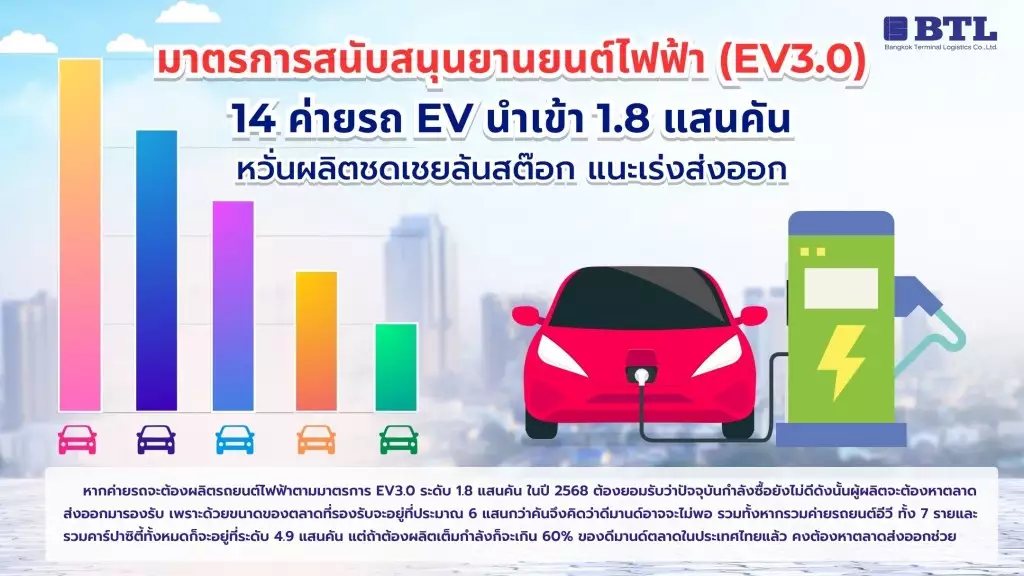



EV3.0 Support Measures - 14 EV car manufacturers import 180,000 cars, fearing production to compensate for excess stock, recommending accelerating exports
The government announced the first phase of support measures for electric vehicles (EV3.0) starting in 2022, which will fully stimulate the electric vehicle market in Thailand and cause new vehicle registrations to grow exponentially during 2022-2023.
The measure will subsidize EV purchases covering cars, pickup trucks and motorcycles, with a discount of 70,000-150,000 baht per vehicle. This subsidy is provided through the car manufacturers, with an important condition that EVs must be produced in Thailand at a ratio of 1:1, meaning that for every car imported, one car must be produced as compensation.
The Excise Department has estimated the production compensation/domestic production according to the EV3.0 support measures. There are 14 car manufacturers participating in total, divided into imports in 2022-2023 totaling 84,195 cars, imports in 2024 totaling 66,448 cars, imports in 2025 totaling 34,386 cars, totaling 185,029 cars imported.
The top 5 car manufacturers for import estimates in 2022-2025 are:
1. Reve Automotive Co., Ltd. (BYD) = 77,274 vehicles
2. Neta Auto (Thailand) Co., Ltd. = 40,837 vehicles
3. MG Sales (Thailand) Co., Ltd. and SAIC Motor CP Co., Ltd. = 27,186 cars
4. Great Wall Motor Manufacturing (Thailand) Co., Ltd. = 24,225 vehicles
5. EV Primus Co., Ltd. (Wuling and Volt brands) = 8,493 vehicles
Car manufacturers that must start compensatory production in 2024 are (considering only imports in 2022-2023 that are due)
1. Reve Automotive Co., Ltd. (BYD) = 38,637 vehicles
2. Neta Auto (Thailand) Co., Ltd. = 16,337 vehicles
3. MG Sales (Thailand) Co., Ltd. and SAIC Motor CP Co., Ltd. = 16,191 vehicles
4. Great Wall Motor Manufacturing (Thailand) Co., Ltd. = 9,645 vehicles
5. EV Primus Co., Ltd. (Wuling and Volt brands) = 1,597 vehicles
According to a news report from the Excise Department , under the EV 3.0 measure, the Excise Department has already paid subsidies to 40,000 operators, and there are still 35,000 operators who have not received compensation. The Excise Department is preparing to propose a budget of 7 billion baht to the Cabinet soon.
In 2024, EV manufacturers will start production lines to compensate at a rate of 1:1 and in 2025 at a rate of 1:1.5. It is expected that EVs will be produced domestically to reach 100,000 units. Companies participating in the project must plan production to compensate for all domestic imports by 2025. If they fail to do so according to the contract, they will be fined, all subsidies will be refunded, and they will have to pay a fine of twice the tax refund.
Mr. Ekniti Nitithanprapas, Director-General of the Excise Department, said that 2024 will be the first year that EV car manufacturers that have signed contracts will start opening factories to produce compensation, which is expected to have EV production in the country this year of 80,000-90,000 units. It will also be the first year that Thailand can export domestically produced electric cars, reflecting Thailand’s position as a car production base, just like it used to produce combustion cars.
Mr. Kritsada Uttamote, President of the Thai Electric Vehicle Association (EVAT), said that if car manufacturers have to produce 180,000 electric cars under the EV3.0 measure in 2025, they have to admit that purchasing power is not good at present. Therefore, manufacturers will have to find export markets to support them because the size of the market to support them will be around 600,000 cars, so they think that demand may not be enough. Including all 7 EV car manufacturers
And the total capacity will be at 490,000 units, but if it has to be produced at full capacity, it will exceed 60% of the demand in the Thai market. We will have to find an export market to help. However, the EV car manufacturers themselves, if they have to accelerate production according to the policy target, will produce back in the proportion of 1:1.
Although the economic situation is not yet favorable, the proportion will still be maintained first, or it may not be the case for all brands. Some brands may use the import method first, and when they have to start production, they will have to clear out the old stock first and find various marketing methods, etc.
Mr. Kritsada said that he admitted that in the current situation, it is considered a supply that comes at a bad time and financial institutions are quite strict in granting car loans. However, it does not mean that the market has no demand, but rather the limitations of lending.
Therefore, in terms of having to produce compensation, no one has an answer yet, even in the National Electric Vehicle Policy Committee (EV Board), which will have to discuss this matter intensively, since the root cause of the problem has just become apparent. However, it must be admitted that the supply is unlikely to be at an appropriate level at this time to start continuous production.
Therefore, it is a big issue that is tied to the country’s macro-economy, that when consumption changes, both in terms of GDP, the NPL rate, and household debt that is soaring, what should be done about lending? Because everywhere must be strict because of concerns about NPLs. But how can we make it move forward as a whole organization, which is a big picture that requires cooperation from many parties?
In addition, when car manufacturers have to produce OEM-style, they have to plan production, such as the competition of each factory, which has many factories. The selection of each factory will be based on the production cost of that factory. This means that reducing production capacity will also increase production costs. Therefore, there will be a loss in production costs per vehicle. When compared to other factories, the advantage in this area may be lost.
This will affect the future of the future model, if it cannot produce at full capacity as planned, the opportunity to produce other models will also be more difficult. “This is a point that we have to look into the future as well, how to make the entire market move forward, because if we can produce, there must be a market in both the domestic market and the export market, then we can plan the production plan.”
Mr. Surapong Paisitpattanapong, Vice Chairman and Spokesperson of the Automotive Industry Club, Federation of Thai Industries (FTI), revealed that the overall picture of new BEV electric vehicles in May had 8,166 new registrations, an increase of 14.50% from the same month last year. In the past 5 months, there were 43,921 new BEV registrations, an increase of 31.64% from the same period last year. Meanwhile, new HEV EVs in May had 10,789 new registrations, an increase of 34.64%, and a total of 59,317 over the past 5 months, an increase of 53.48%. As for new PHEV EVs, there were 704 new registrations, a decrease of 31.32%, and a cumulative total of
The number of vehicles produced in the first 5 months was 4,053, down 22.01% from the same period last year. However, if we look at the figures for the first 5 months, EV production in Thailand is at 5,000 units. Therefore, the FTI will have to closely monitor the situation of the manufacturers who have signed up to receive benefits from the government, around 7 Chinese brands, to see if they are ready to produce according to the target or not.
“The key to achieving the production target is batteries and various supply chains, which may need to be imported at this time. The only clear chain is BYD, which has already set up a factory. Therefore, we need to look at other manufacturers to see if they are ready or not.
If the supply chain and supporting market are ready, we will be able to produce to meet the excise tax target,” said Mr. Surapong. The total number of registered EVs is more than 175,316, which is a 168% growth. Currently, production in Thailand has begun to increase. This year, more than 5,000 units have been produced and will start to increase in the following months.
Therefore, Thailand will continue to be a production base for internal combustion vehicles for export, including an EV production base for export, and will grow more than in the past. Last year, more than 1.1 million internal combustion vehicles were exported. This year, EVs may be exported in Thailand as well.
Source of information: Bangkok Business